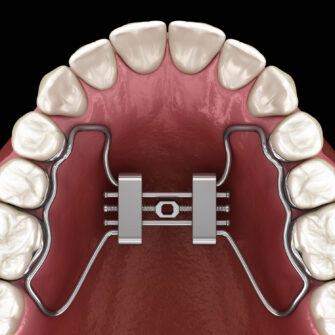Like traditional braces, clear aligners are designed to move your teeth gradually. They put gentle pressure on your teeth to slightly reposition them, straightening them slowly over time. Clear aligners are one of many technological advancements that orthodontists use to create healthy, beautiful smiles.
What are Clear Aligners?
Clear aligners offer an aesthetic alternative to traditional metal braces. Unlike the brackets and wires of braces, clear aligners are virtually invisible and are made from smooth, transparent, medical-grade plastic. They are custom-fitted to wrap snugly around the teeth, ensuring comfort and improved esthetics.
Unlike fixed traditional braces, clear aligners can be removed to allow you to maintain your usual diet and hygiene routine. However, for best results, it’s critical to wear your aligners for 20-22 hours per day or as prescribed by your orthodontist.
How Do Clear Aligners Work?
Like traditional braces, aligners are designed to shift your teeth into their desired position gently. Before starting treatment, your orthodontist will check your teeth and jaws using X-rays, photos, and digital scans. With the information gathered, your doctor will provide a diagnosis before designing your smile and treatment plan in the aligner software. This details which tooth moves where and in what order, guiding your teeth into healthy positions.
Clear aligners aim to create a healthy bite by repositioning all teeth, not just the few that are seen when you smile. It is important to remember that moving teeth is a complex biological process and needs start-to-finish supervision by an orthodontist.
Finally, aligners are created using your initial impressions or digital scans as the starting point. On average, each set of aligners is worn for a week or two before switching to the next set. The total number of aligners will depend on your specific needs. Wearing them consistently and as instructed by your orthodontist will help insure your teeth reach their ideal positions.
The Advantages of Clear Aligner Therapy
Clear aligner therapy offers several advantages over traditional braces. These benefits contribute to this treatment method’s rising popularity among patients and orthodontists:
Aesthetics
One of the most compelling advantages of clear aligners is their near invisibility. Made from clear, BPA-free plastic, they are far less noticeable than metal braces. This aesthetic appeal is particularly valued by adults and teens who may be self-conscious about the appearance of traditional braces.
Comfort
Aligners are smooth and custom-made to fit directly over your teeth minimizing discomfort.
Improved Oral Hygiene
The removability of clear aligners is a significant advantage when it comes to oral hygiene. Unlike fixed braces, aligners can be removed for brushing and flossing, allowing you to maintain a more effective oral hygiene routine. This removability also means there are no food restrictions, as there are no wires or brackets that food can get caught in or break.
Treatment Time and Flexibility
For many patients, clear aligner therapy can be faster than traditional braces, depending on the case’s complexity. Aligners move teeth precisely and efficiently to reduce treatment time, and can be removed to offer flexibility not possible with braces.
The Limitations of Clear Aligners
Clear aligner therapy has many benefits but may not work for all orthodontic issues. Depending on your specific case, braces may be necessary.
Clear aligners may not work as predictably for severe malocclusions, significant tooth rotations, and large gaps. Traditional braces may offer more precision in these cases. Secondly, the success of clear aligner treatment heavily relies on your compliance. Since they’re removable, inconsistent aligner wear can hinder your progress, extending the length of treatment or compromising the results.
Aligners can trap liquids and food particles against the teeth, increasing the risk of cavities and gum disease.
Best Practices for Clear Aligner Treatment
To ensure the best results, there are a few critical best practices you should follow while undergoing clear aligner therapy, including:
- Avoid any drink that is not water while your aligners are in. Liquid trapped against the teeth may stain the aligner and teeth, and can cause cavities to develop.
- When you remove your aligners, make it a habit to slip them into their case. Do not place aligners in napkins, a pocket, or a purse; keep them away from pets.
- After eating or drinking, brush your teeth thoroughly before re-inserting your aligners.
If you should lose or damage an aligner, contact your orthodontist immediately for advice.
Are Clear Aligners Right for You?
The best way to decide which orthodontic treatment is best for you is to consult an AAO orthodontist. The American Association of Orthodontists (AAO) is open exclusively to orthodontists who have graduated from dental school and completed an accredited orthodontic residency program.
Because of their extensive education and familiarity with the many types of appliances used to move teeth and align jaws, orthodontists can recommend the best treatment for your goals and lifestyle needs. Many AAO orthodontists offer complimentary or low-cost initial consultations, as well as a variety of affordable payment plans.
With an AAO orthodontist, you can achieve your perfect smile with ease. Find an Orthodontist and schedule your initial consultation today.



